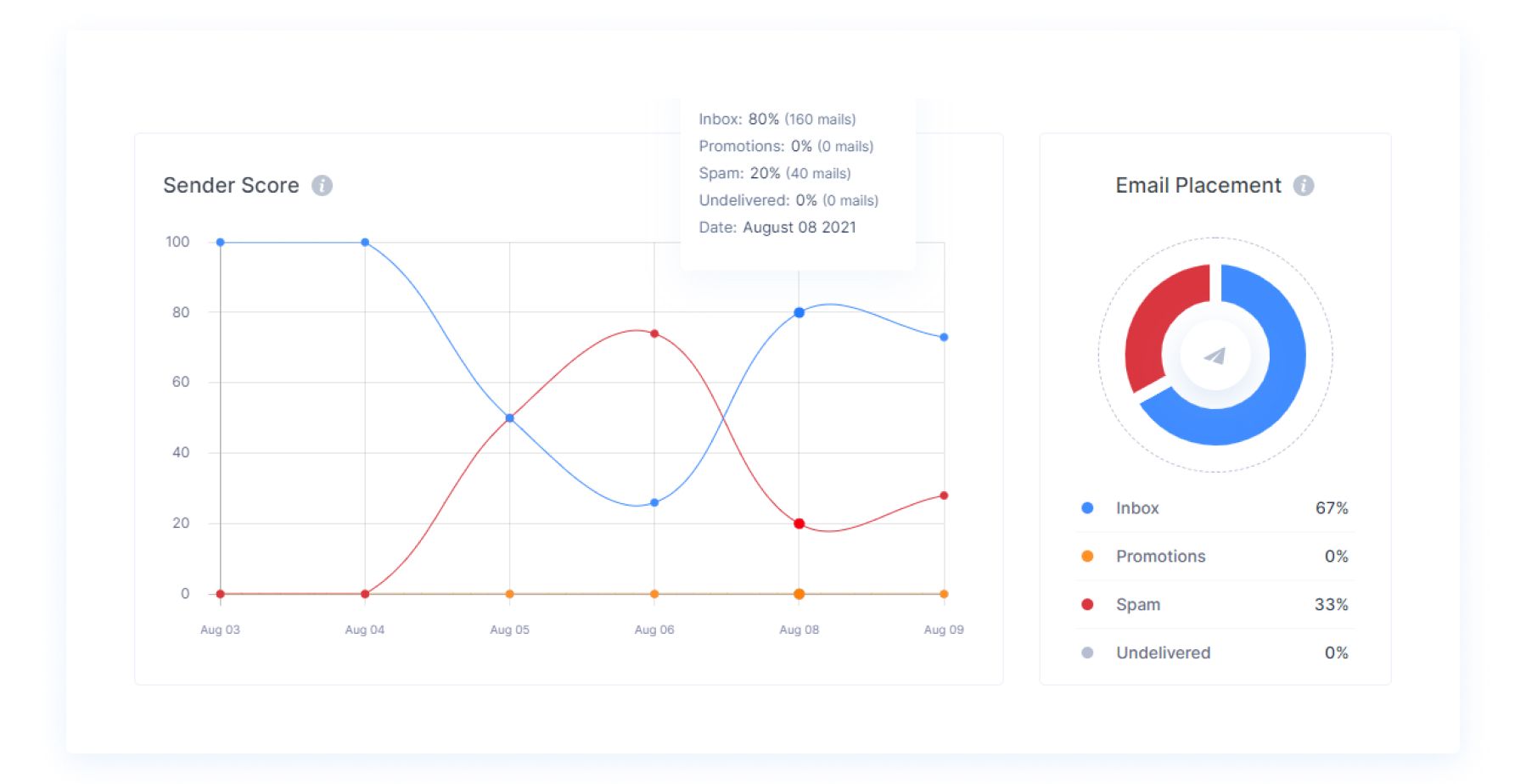Your performance may be great, and you may have overcome the hardest obstacles, but in the world of B2B outreach and complicated mail transfer algorithms, you can never catch a break.
Belkins, a B2B lead generation agency, offered its services and became a reliable acquisition partner for the Columbus Chamber of Commerce, the Texas Association of Business, Andersen and many other prominent organizations operating in Software Development, Marketing & Advertising, and Non-Profit industries. Offering an innovative solution, such as LinkedIn Influencer Program, and providing assistance with email campaigns, Belkins managed to make it through the crisis caused by COVID-19 and help several companies with retaining clients and nurturing new connections.
However, after achieving stability, Belkins team decided to inspect their email marketing performance stats closely and discovered a drop in email deliverability statistics.
To remedy this issue and accelerate the company’s plans, the Belkins team started looking for ways to ameliorate email deliverability and expand their toolset with new solutions. In their search, Belkins team reached out to Folderly experts.
Breaking point
“With this issue and our work, we realized that solving it on our own would take too long. We wanted to locate the root of the problem ASAP, and we were looking for someone who would approach our setback with a fresh mind and tell us what we were missing.”
Belkins was motivated to consult mailbox engineers and utilize new tools due to the following issues:
1) Low email deliverability performance. Email marketing played an important role in gleaning MQLs, service promotion, and generating new leads. It’s a very rewarding channel, but not without its complications. For example, Belkins team noticed a sag in statistics for the company’s mailboxes.
For a business that expands with each new partner and each new client, it’s vital to keep its cold outreach channel productive and steady.
Whether you start a new campaign or create a mailbox for a new sales rep in your company, mailbox warmup should come first. Without it, you’ll quickly ruin internet service providers’ trust in your domain and make it to the blacklist. Mailbox warmup is important for introducing new elements of your cold outreach to the systems that are in charge of your recipients’ safety.
2) Ameliorate email deliverability. Email deliverability is a complicated, multi-level process that involves more than one metric. Belkins needed a tool and professional advice for keeping an eye on all performance indicators and responding to any significant changes in time.
A high email delivery rate is not a benchmark that you can achieve, set in stone and never worry about again. It requires constant attention and adjustments in order to stay where it is. Whenever your engagement rate goes down or a mailing service starts rejecting your emails, your email delivery rate would instantly change for the worst, reflecting your outreach dynamic. So, you must be on the lookout for new practices and email deliverability audit tools.
Summary
“With Folderly, we scanned our mailboxes with surgical precision and mapped out the key problems in a matter of a day. From that point, it was about building the right strategy and carrying it out.”
1. Research. We outlined the key pain points for Belkins and used Folderly's email deliverability test and audits to find the root cause of the problem.

After receiving a detailed Folderly report, we got a clear view of the core issues that led to the deliverability drop.
- DNS settings. The DNS settings are responsible for pointing email traffic to receiving servers and email management needed revision. We looked through Belkins’ SPF record, MX record and DMARC policy to locate any conflicting modifiers and ensure the absence of duplicate records.
DNS records contain information that is scanned and analyzed by receiving servers. They manage the flow of your email, protect your sender reputation from spoofers and phishers, and provide instructions on dealing with suspicious emails. Also, they are extremely complicated, so we often advise against editing or adding new DNS records on your own. Any unnecessary tweak can open a can of worms and cost you months of reputation-fixing.
- Email templates. Marketing templates used by the client had an imbalanced text-to-HTML ratio because of the visual elements.
Adding too many graphic elements to your email template can lead to recipient servers having problems with downloading it. Whenever an email service comes across a message that cannot be downloaded with all its elements, it instantly raises suspicions about the sender. When the sender continues to send such emails, email service providers treat it as a red flag and start re-directing them to spam folders.
2. Troubleshooting. With key issues detected, we set off to solve them, step-by-step.
- Fixing DNS settings. We investigated the client’s DNS records by running a mailbox audit with our Folderly tool, which revealed a major SPF issue. After studying the TXT record itself, we realized that it exceeded its number of lookups due to its length.
DNS lookups is a term used for the number of times an email service provider can check the component of your SPF record. The average lookup limit for an SPF record is 10 lookups. If you exceed that limit before the recipient’s service provider is done processing your email, it will treat your message as if it has failed the authentication check. This limit exists because email service providers check each mechanism and modifier of your SPF record separately. Each time they request information from the DNS, it increases the processing time and resource consumption. So, the more modifiers and mechanisms your SPF has, the more problems it creates.
To remedy this, we used our Folderly SPF Record Maker tool to rework Belkins’s SPF record into its shorter yet indefinitely effective version.
Forlderly SPF Record Maker allows senders to generate a customized TXT record that would include all domains they use for email marketing, all mail service they send email to and pick a policy regarding processing emails that failed the authentication check.
Having created a new SPF record, we sent it to the client who implemented it and waited for the changes to settle in.
- Editing templates. Together with Belkins, we revised all email templates, removing HTML elements that were putting email service providers on high alert.
With Folderly deliverability audit, the client found out that Outlook had a low tolerance for HTML templates, even with correctly-sized visuals. Belkins’ team created a simple text version of marketing templates for Outlook and started the campaign monitoring.

- Mailbox warmup. With Belkins’ team working on clients’ campaigns, Folderly assisted with designing new warm-up practices for new inboxes. We pinpointed the best time slots for sending warm-up emails. Additionally, we established the time periods within which it would be possible to increase the number of emails sent from new addresses.
Following our advice, Belkins used Folderly audits and reports to monitor the message journey for each new inbox after moving on to the new warm-up stage. Folderly reports provided a great insight into how spam filters and receiving servers respond to outbound emails sent from the Belkins domain. The reaction on behalf of various spam filters was the most important since it determined whether the emails would be allowed to access the recipients’ inboxes.
Such a practice allowed us to make sure that the warmup is going as intended and timely inform the client about upcoming changes.
- BIMI record fine-tuning. Belkins already had an implemented BIMI record for better brand visibility, but since it’s a relatively new feature still tested by Gmail, Yahoo! and other email service providers, the company’s logo wasn’t always displayed as expected.
BIMI in Gmail: Gmail started beta-testing its BIMI standards in 2020. This should give you an idea of how new BIMI is to the world of outreach. Sometimes, your BIMI logo won’t get displayed due to syntax errors or the wrong SVG format. Sometimes, low domain reputation is to blame. Sometimes, it’s because the receiving server doesn’t support BIMI. Only a qualified expert can figure out the exact reason and explain how you can fix it, so don’t hesitate to seek professional advice.
With the help of the Folderly deliverability test, we were able to see that the issues with the BIMI record were caused by the SVG format and make the necessary changes.

Results
“We’re not new to cold outreach, but this was an eye-opener. Our company is going through some growing pains right now, so there is a lot on our plate. Folderly helped us scale our outbound marketing work and made sure we would not lose a single opportunity.”
- Delivery rate stabilized. After deploying the new, improved SPF record and cleaning marketing templates, we closely observed the delivery rate. In the first months, the deliverability drop has slowed down. By month 3, it started going up, returning to its normal state.
- Open rate progressed. With outreach and deliverability challenges removed, Belkins’ team started seeing more opens and interactions with their cold emails. This signified that the new SPF record was implemented properly, and Belkins campaigns started getting more visibility. It also meant that the email service providers didn’t have any issues with the new templates.

- More MQLs processed. After new templates got greenlit by Outlook, Belkins marketing team managed to increase the amount of marketing-qualified leads by 40% and received more accurate data on new email marketing campaigns.
- Warmup efficiency increased. With more insights granted by the Folderly tool, Belkins team was able to manage mailbox warmup more efficiently, enjoying clean data on the performance of each new mailbox and pinpointing the right time for picking up the speed.

Key takeaways
- Test your SPF record after every change. Whenever you have to edit your SPF record, take some time and do some testing to make sure it works as intended. When in doubt, ask a DNS record expert to take a look at your freshly edited stuff and see if there is a problem or whether they could’ve done it better.
- Update your tools. If you feel like you’ve squeezed everything you could out of your current deliverability tool, don’t hesitate to look for new options. When you experience the need for new solutions, it’s a good sign. It means that your business is growing, your target audience expands, and you just need something to match that scale.
- Get to know your recipients’ mail services. All email service providers are different. What went well for Gmail won’t be accepted by Outlook and vice versa. Your goal is to keep that in mind and always monitor your email campaigns.
- Don’t go easy on yourself. Get inspired by your achievements and victories, but pay attention to the smallest details. Your tremendous success can get compromised by a tiny issue that wasn’t fixed in time. Losing months of hard work and having to start again because of just one small thing is a nightmarish perspective, but it’s quite real. Don’t hesitate to connect with professionals and ask them to provide their perspective whenever your sender sense is tingling and you just know something isn’t right.

